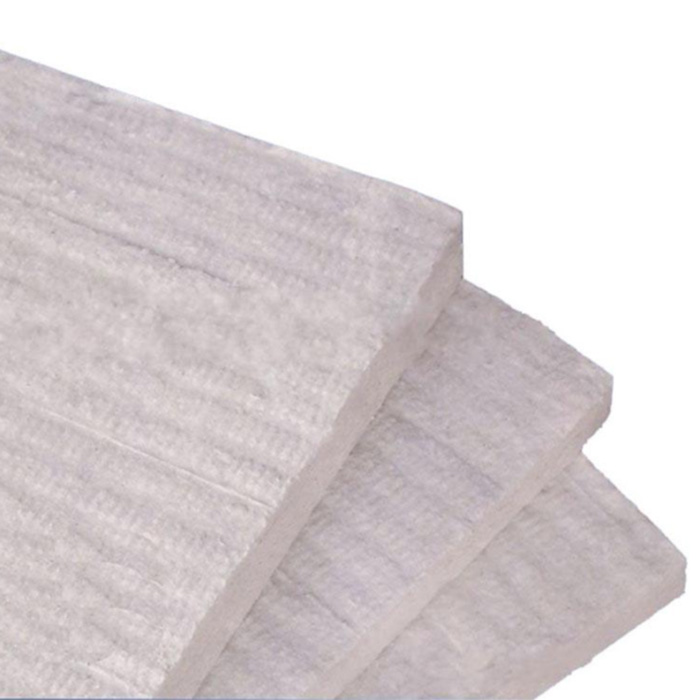Definition: ceramic fiber board usually refers to hard flat refractory ceramic fiber products containing inorganic or organic binders. Ceramic fiber boards are produced by wet method. The so-called bonding agent of ceramic fiberboard refers to a substance that is added to non-plastic granules or fibrous materials to provide workability and green strength or dry strength.
The so-called refractory ceramic fiber refers to an artificial mineral fiber suitable for use as a heat insulation material at a temperature of 800 ° C or more. Ceramic fiber board has the following 6 characteristics:
1.Classification temperature
The classification temperature refers to the highest temperature at which the linear shrinkage is less than a given value. This temperature is expressed in ° C and at intervals of 50 ° C. According to GB / T17911-2006, the heating permanent line change of refractory ceramic fiber products is measured. The test temperature at which the shrinkage of heating line of refractory ceramic fiber boards and shaped hard products does not exceed 2% is the classification temperature. In GB / T3003-2006 "Refractory ceramic fibers and products", the classification temperature of ceramic fibers and products is divided into 19 levels, starting from 850 ° C and ending at 1750 °C.
The classification temperature, which characterizes the heat resistance index of refractory ceramic fiberboard, is the most basic performance to ensure the correct use of refractory ceramic fiberboard.
2.Bulk density
Bulk density refers to the ratio of the dry mass of ceramic fiberboard to its total volume. Generally, the bulk density of ceramic fiberboard is in the range of 200 ~ 500kg / m3. In GB / T3003-2006 "Refractory ceramic fiber and products", ceramics There are 8 kinds of nominal values of volume density of fiberboard: 260, 280, 300, 320, 340, 360, 380, 400kg / m3.
3. Compressive strength

Ceramic Fiber Board
Refers to the ultimate load that a rigid ceramic fiber product can withstand per unit area at room temperature. Compressive strength is one of the important performance indicators for measuring the quality of rigid ceramic fiber products, which can indirectly reflect the product's organizational structure, such as compactness, uniformity, and sinterability.
4, heating permanent line changes
Under no external force, the refractory is heated to a specified temperature, kept for a certain period of time, and the linear expansion or contraction remaining after cooling to normal temperature. Research results at home and abroad show that the heating wire change test of ceramic fiber products requires heat preservation for 24 hours. The linear shrinkage of ceramic fiber products after the heat preservation test for 24 hours reaches more than 75% of the linear shrinkage after long-term use. The results of the heating line shrinkage test characterize the permanent heating line change during long-term use of the product.
The shrinkage of the ceramic fiber's heating wire is meaningless to a single fiber. It is only related to the ceramic fiber product and is directly related to the fiber crystallization and grain growth. At the temperature before the crystallization started, the fiber has maintained its original In the glassy state without significant creep, ceramic fiber products do not shrink. As the glassy fiber begins to crystallize, individual fibers are curled, which in turn causes ceramic fiber products to shrink. Internationally stipulated that the sample is kept at a certain temperature for 24 hours, and the test temperature for which the heating linear shrinkage does not exceed 2% is the allowable long-term use temperature of the ceramic fiber board. And the grain growth speed is slow, the fiber performance is stable, the fiber is soft and elastic.
5. Thermal conductivity
The thermal conductivity characterizes the thermal conductivity of a substance, and its numerical value refers to the heat per unit area when the temperature difference is 1 ° C per unit length per unit time, and the unit is W / (m.k).
6, combustion performance
Combustion refers to the exothermic reaction of a substance under the action of an oxidant, usually accompanied by the generation of flame or visible light. In GB / T16400-2003 "aluminum silicate cotton for thermal insulation and its products", it is stipulated that the product with a binder should have a combustion performance level of A (non-combustible material)
We are ceramic fiber insulation supplier. In addition to ceramic fiber board, we also have ceramic fiber pipe. If you have any requirements for our products, please feel free to contact us.
Copyright © Tianjin Haimen Building Materials Co., Ltd. All Rights Reserved
Sitemap
